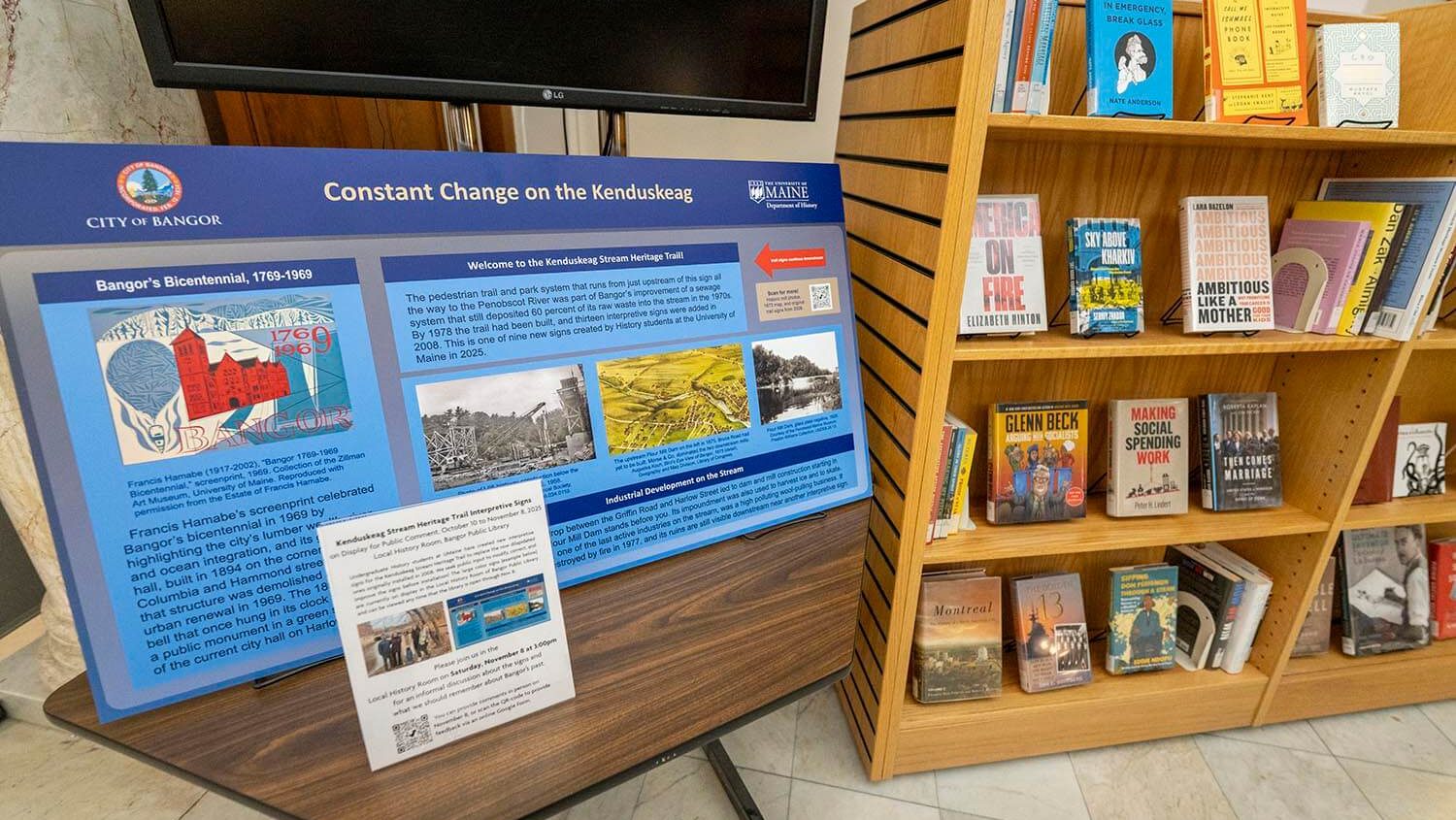
Kenduskeag trail receiving new, improved Bangor history signs from UMaine students
The Kenduskeag Stream Heritage Trail in Bangor is getting a fresh set of interpretive signs — created by University of Maine history students to replace the aging displays that once lined the 2.2-mile path.
The new signs, now on view in the Bangor Public Library’s Local History Room, explore topics including author Stephen King’s ties to the city, Bangor’s lumber boom, the Great Fire of 1911, the Kenduskeag Stream Canoe Race and Wabanaki history. Each display pairs written history with images and QR codes linked to videos, music, archival photos and local organizations.
Some of the panels update information that appeared on the original signs installed in 2008, while others introduce new stories that have never before been featured along the trail. The city plans to install the new signs later this year.
“The opportunity to illustrate the history, information and stories about the Kenduskeag Stream through this partnership has been fantastic,” said Bangor Parks & Recreation Director Tracy Willette. “The final result will contribute to our overall efforts to enhance the Kenduskeag Stream Heritage Trail.”
Before the signs are installed, the city and Liam Riordan, professor and chair of history at UMaine, are seeking public feedback through an online survey open until Nov. 8. The city will also host an informational meeting and seek public comment about the signs at 3 p.m. Nov. 8 at the Bangor Public Library.
“We are pleased to host this meeting to provide an opportunity for the public to learn more about the signs and give their feedback,” said Greta Schroeder, local history and special collections librarian at Bangor Public Library.
In a fall 2024 senior capstone course, Riordan guided eight students, including Liv Neuhauser (‘25), with designing the new signs after conducting extensive research on their self-selected topics.
For the Stephen King display, Neuhauser said she combed through newspaper archives and academic articles, visited landmarks such as the Thomas Hill Standpipe referenced in King’s books, reread several of his novels and contacted artists who create King-related merchandise.
From that research, Neuhauser developed both the interpretive sign and a walking guide pointing readers to real locations featured in the stories. The Bangor Parks and Recreation Department, Bangor Public Library, Bangor Historical Society, UMaine’s Zillman Art Museum and Special Collections at Fogler Library supported her and her classmates throughout the project.
“I think the way we approached the project strikes a balance between Bangor pride, pop culture and the complex history Maine and this specific area has to offer. I hope it inspires people to keep exploring the state, the city and, of course, Stephen King,” said Neuhauser, who graduated in May with a dual degree in history and secondary education and teaching. “For residents, I hope it fosters a renewed sense of pride in Bangor’s creativity and its influence on King’s work, as well as gratitude for the ways he’s given back to the community.”
Neuhauser is now pursuing a law degree at the University of Maine School of Law, but she still fondly recalls Riordan’s mentorship in “translating scholarship into something meaningful and approachable for a community, not just for other historians.”
She is now applying the skills she learned in his course toward her career endeavors, she said.
“Turning research and academic work into something accessible and understandable is absolutely a skill I plan to carry forward into my career as a Juris Doctor candidate,” Neuhauser said. “Being able to communicate complex, or at times dull, information in a way that keeps others engaged yet informed is a skill I’ll continue to refine and apply when working with future clients.”
As part of the fall 2024 course, students presented their work at two Bangor City Council meetings and at the Maine Archives & Museums Annual Conference in Lewiston. In addition to public speaking and research experience, the project helped the group build strong connections through off-campus field trips, shared nerves and the collective push to complete the project.
“Creating space to explore our shared past is essential for more meaningful civic life,” said Riordan. “Students appreciated the public qualities of the work that we did in this class, and I look forward to building richer off-campus partnerships in the future, particularly in an entry-level Introduction to Public History course that I will teach in fall 2026. Seeing students grow as they presented their plans to city officials, sought input at public events and participated in a professional conference, all in a single semester, was pretty amazing.”
The city will use the student-researched signs as part of a larger effort to restore and upkeep the trail, a popular destination for city residents and visitors.
The City of Bangor Parks & Recreation Department has started replacing lighting along the trail and dedicated $40,000 in capital funds to enhance it, which includes fabricating and installing new signage, replacing fencing and making overall trail improvements.
Contact: Marcus Wolf, 207.581.3721; marcus.wolf@maine.edu
